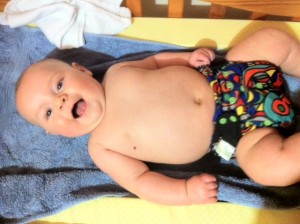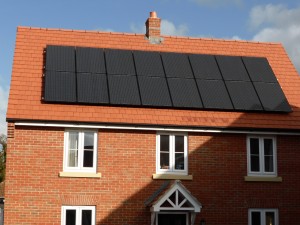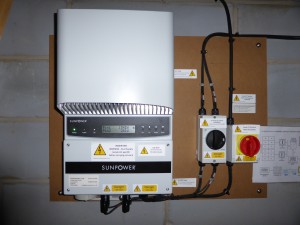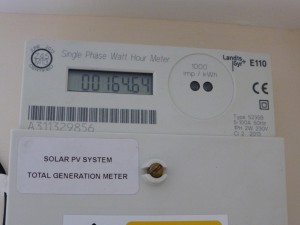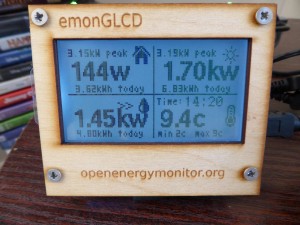Adventures in washable nappies
This is Matthew. He's wearing a washable (or reusable or "real") nappy:
While we were expecting him I spent a LONG time researching these bad boys and so I thought I'd take a few minutes to share my findings. I'd vaguely assumed that reusable nappies hadn't changed much and were still awkward folding bits of cloth held together with safety pins. I was wrong!
Benefits
There are some huge bonuses to washable nappies. Firstly, there can be a significant environmental benefit. Disposable nappies biodegrade very slowly and an average infant can easily get through thousands before being potty-trained. These end up in landfill. It's estimated that washable nappies are 40% better for the environment, and if they are also used by younger siblings this can easily be more. Of course, these benefits are shot to pieces if you don't have a very efficient washing machine (or tumble dry your nappies). However, most modern washing machines are incredibly efficient and you can usually wash at 40 degrees these days.
There's also a significant financial benefits. For a few hundred pounds you can get a set of good washable nappies (I recommend The Nappy Lady) which will last from birth to potty (and will be fine to use for further children too, you can even sell them used on eBay). The only ongoing costs are associated with extra runs of the washing machine, and you might need to buy extra liners from time to time. You can have a read of a cost comparison on Fill Your Pants.
In addition, washable nappies come in a range of cute designs. We like the Bumgenius Freetime as an example of a well-fitting, quick drying, stylish nappy. But there are loads of options available! The Nappy Lady offers an advice service and will suggest some options based on your own priorities.
Finally, washable nappies tend to be nice to a baby's skin. Soft fleece liners sit next to baby's bottom and take liquid away from the skin very efficiently. Anecdotal evidence suggests that well-fitting washables can be better at containing wee and poo than disposable equivalents, particularly the more violent poo-explosions.
Practicalities
Of course there are some practicalities when it comes to washable nappies. They aren't for everyone.
We end up doing a nappy wash around twice every three days, but all of his clothes, wipes and muslins and things get chucked in with the nappies. As a result there's a bit of extra effort here but it's no more bother than any normal load of washing. We dry the nappies on an airer (or outside on the line on sunny days); if you don't have outside space or have a house that makes drying on an airer difficult this may be a snag for you.
But isn't it all a bit unsanitary? This can (and should) be a concern to any new parent. We've found little problem in this regard. We wash nappies at 40 degrees (occasionally 60) with some Mio Fresh nappy sanitiser to sort out any bacteria. I also bought a bidet attachment like this for the toilet, which we use to rinse off any poo before the dirty nappy goes in the wash bucket.
What about being out-and-about? Like anyone else we have a change bag and this includes a waterproof wet-nappy-bag (with dinosaurs on it). This just gets emptied into the bucket when we get home. No problem!
If you have any questions about the practicalities please leave a comment and I'll try to respond.
What we use
We've invested in a range of different nappies. Our favourite is the Bumgenius Freetime. It comes with poppers or Velcro and is adjustable to fit from birth (about 8lb) to potty training. The absorbent flaps fold out which means it dries on an airer pretty quickly and it comes in a nice range of colours and designs. It's been really good in terms of containment and absorbs a lot of pee.

Bumgenius Freetime "Albert" design
For "day" nappies we also use the Charlie Banana one-size. This is another birth-to-potty adjustable nappy but uses a pocket system into which you insert an absorbent pad. These are slimmer fitting than the Bumgenius but, as a result, need changing more frequently as there is less absorbancy. The main nappy dries very quickly and the pads dry quickly too.

Charlie Banana "Robot Boy" design
At nights we often use Big Softies with an extra pad for maximum pee absorption to minimise night changes. These use a separate waterproof wrap (we use the Motherease Rikki) and can last for hours and hours without needing a change (assuming they remain poo-free).

Big Softie
To help preserve the nappy we use fleece liners. These enable any liquid to wick away from the skin but also catch poo to avoid staining. They get rinsed in the loo if needed before being put in the bucket ready to wash.
Finally, we have some washable wipes to wipe and clean between nappies. One side is cotton, the other is fleece. This means that they are nice and soft just to wipe around the area (fleece) but the cotton side is great for dealing with the nastier products of a baby's bottom. They hold together much better than disposable wipes and simply go in the wash with the rest of the nappies after use!
Conclusions
Before I started looking into them I'd assumed that washable nappies weren't really a viable option any more. However, with a little bit of effort I've found that there are loads of benefits. For any new(ish) parents or parents-to-be I'd encourage you to investigate; disposable nappies are not the only option! I accept that there are lots of possible reasons why washables aren't suitable for everyone. Fair enough. However, the disposable nappy manufacturers can make it seem like there's no real choice; please be encouraged to look at what's available.
Adventures in solar power
In recent years I have been trying to reduce my environmental impact as part of a commitment to stewardship. One aspect of this is recently having had some solar PV panels installed and this post is a brief introduction to what's involved.
What we've got
Our installation consists of 16 Bisol 250W panels (Peak Performance Polycrystalline). These will generate a maximum of 4kW of electricity at any one point (when in direct sunlight) and sit on the roof!
We also have an Aurora Power-one 3.6kW inverter sat up in the loft. This takes the DC power generated by the panels and converts it into AC connected into the rest of the house. It works by converting DC into AC at a voltage slightly higher than the national grid, this then flows around the house and the appliances can use the energy generated.
The output from the inverter comes through a Landis & Gyr generation meter which makes a note of how many kWh of energy have been generated (just like a normal electricity meter measures how much energy is being used).
We also have an Apollo GEM immersion heater control unit. This comes into play because any energy generated that isn't used by the home at the point of generation normally gets exported out to the grid (and will probably be used by the people next door). This isn't really a problem, but it makes sense to use as much of the energy you generate as possible. The GEM unit therefore monitors how much electricity is being exported to the grid and then diverts that energy to the water tank immersion heater instead. Therefore, on a sunny day, the solar panels will heat the hot water too! (This saves me importing gas to heat the water).
Finally, I built a little energy monitor built around the Open Energy Monitor platform. It displays current usage (top left), generation (top right), energy diverted to the immersion heater (bottom left) and temperature (bottom right). [I'll post the Arduino sketch that runs it at some point.]
Environmental Impact
There's an obvious impact on the environment. Since the panels were installed (roughly a month ago) I estimate that they've saved 170kg of CO2 from being released into the atmosphere through burning of fossil fuels in a power station. Over a relatively dark month of the year that's quite a lot of emissions saved. Over the course of the life of the system there should be a significant saving here. You can keep track of my up-to-date statistics at pvoutput.org
Financial Impact
There's some confusion over the financial implications of having solar panels installed. At the moment (assuming you pay for the installation yourself through an MCS accredited installer) you'll get the following in terms of return on your investment:
- The Feed-in tariff (FIT). This is a payment from the government (administered through your electricity supplier) for every kWh of energy you generate. It doesn't matter how much of that energy you actually use, you get paid based on the amount generated. At the moment the tariff is 14.9p/kWh of energy generated, so if my panels generate 10kWh in a day I'll get £1.49. The FIT payments are made quarterly straight to your bank account and these are guaranteed by the government for 20 years from the date of installation and the rate will increase in line with inflation. According to the standard estimation model I expect to receive around £500-600 over the next year from this. (Up-to-date values for the FIT are available from Ofgem. Beware, these are being cut by the government on a regular basis!)
- The Export Tariff. In addition to payment for any electricity generated you also receive a payment for any energy exported back out to the grid (ie. any electricity you generate but don't use). This is currently set at 4.77p/kWh exported. However, most installations don't actually measure how much electricity is exported and so installations are assumed to export 50% of what they generate. In effect, you can therefore add 2.4p to the FIT which makes my annual cash return more like £600-700.
- Reduced electricity bills: This is fairly obvious! For every unit of energy I generate and then use within the house that's also a unit of energy I no longer need to import from the grid and pay for. It's a bit hard to estimate how much we'll save because it requires some changes of thinking but the saving could easily hit £100/year (and this will increase as electricity prices continue to rise).
The system cost just under £7,000 to install and it's estimated that we'll recoup that money in around 8 years. That sounds like a fair amount of money, but if you happen to have some money sitting in a savings account doing very little (that you won't need access to as cash) it makes a healthy ROI.
Things to consider
There are quite a few factors to consider when investigating solar PV. Here are a few things that I discovered along the way...
- Get a good range of quotes from MCS accredited installers. We used a company called SolarWorks in the end and I'd recommend them. However, getting a range of quotes never hurts!
- Make sure your quotes are reasonable! There are lots of cowboys out there who promise the earth and don't deliver. Any quotes you get should take into account the orientation of your roof (facing due south is optimal), the pitch (slope) of the roof, the area you are in, and any shading that obstructs light getting to the roof (trees etc). There's a standard assessment procedure for estimating the yield from a solar PV system; if a quote doesn't refer to it then be skeptical. You can use the EasyPV performance estimator to get a sense of roughly how much electricity you can expect to generate.
- Check your warranties. Industry standard seems to be about 10 years for both parts and installation.
- Check if you need permission. You shouldn't need planning permission as most installations are considered a "permitted development" but it's worth checking. You should also speak to your mortgage lender if you have one - they have an interest in your property and will want to make sure their investment won't be compromised. We also found that there were restrictive covenants in the deeds to the house (ie. we needed to get permission from the builders to alter the external appearance).
- Check your home insurance. Our home insurers (Direct Line) covered the installation of solar panels by default, but it's worth checking!
- Think about the future. Solar panels are a fairly long-term investment (you're looking at 10 years until you really get the financial benefit). If you're likely to sell your house within 10 years then you may not get the return; solar panels may help you sell your home but are unlikely to add enough value to offset the cost.
- Check the current efficiency of your home. You can't get the full feed-in tariff on a home that doesn't meet minimum energy efficiency requirements (currently your property needs to be rated D or better. See the Energy Saving Trust website.
Conclusions
I'm really pleased with what we've had done. They should reduce our grid energy usage significantly (you can see a live update of how much we're making/using here); this particularly applies now we use the washing machine A LOT (thanks to investing in washable nappies, but that's the topic for another post).
It's made me rethink how I use energy (we now use the washing machine/dishwasher more in the afternoon when we are generating the most energy) in order to optimise our consumption. I'm looking forward to the summer when I can turn off the boiler and generate all our hot water from the panels as well as enjoying minimal imported electricity.
If you have the cash to invest I think it makes a promising financial investment, as well as an environmental one.
Current output information:
You can also check The Bigg House twitter feed.
